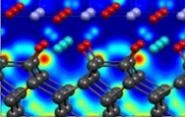At the Oxide Interface: Where Experimentalists Play

04/03/2009
Departments: Applied Physics, Mechanical Engineering & Materials Science
For many materials scientists and applied physicists what goes on at the interface between two different materials is where the excitement is. Long gone are the days when electronics developers glued materials together by hand. Today’s materials are sandwiched together with atomic-scale precision – an advancement that has led to the control of exotic solid-state phenomena, such as magnetism and superconductivity at the nanoscale and a promise of applications that will have broad-sweeping impact on the technologies of our time.
In 2005, the National Science Foundation awarded a six-year, $7.5 million grant to establish a Materials Research Science and Engineering Center (MRSEC) at Yale, known as the Center for Research on Interface Structures and Phenomena, or CRISP. Since that time, a multidisciplinary group of physicists, applied physicists, chemists, and mechanical, electrical and chemical engineers – comprised of both theorists and experimentalists - has produced some of the leading research in the world on atomically engineered materials and interfacial phenomena.
Their work revolves around crystalline oxides –common compounds that can exhibit nearly every possible effect seen in solid-state physics, ranging from magnetism to superconductivity. Because of their lattice structure, crystalline oxides of different chemical composition are easy to stack, allowing for atomic-scale sandwiching of a variety of materials. Of course, “easy” is a relative term. It can take up to a few years to figure out how to construct such structures and requires expensive equipment that can create the ultra-clean vacuum of outer space needed to protect these delicate structures from contamination.
That is not a problem for CRISP, which houses four oxide molecular beam epitaxy (MBE) machines, sophisticated vacuum systems that grow materials a single atomic layer at a time. Any research institute would be fortunate to have one of these machines, let alone four. Of more importance, though, is that according to professor of applied physics, Charles Ahn, CRISP has two of the best crystalline oxide MBE “growers:” Fred Walker, recruited from Oak Ridge National Laboratory, and Jim Reiner, associate research scientist. In a recent review article published in Science on this topic, these CRISP members describe the exciting work on interfacial phenoma – including the discovery of new behavior and breakthrough technological applications – that is just beginning.
What researchers around the world have begun to explore are the interesting and often surprising phenomena that occur at the interface between two materials. One striking example is the recently developed interface between two oxides, which alone are insulators, but when precisely layered at the atomic scale display conducting or superconducting properties where the two interact. This exciting development was reviewed by CRISP in a Nature article in December last year. More recently, CRISP researchers, Jason Hoffman and Carlos Vaz, have been able to atomically engineer a multiferroic structure in which magenetism can be controlled by applying an electric field to the interface of a ferromagnetic and a ferroelectric oxide (hence the name multiferroic).
Given the amount of time it takes to engineer oxide interfaces, there is a backlog of experiments waiting to be run. Fortunately, CRISP experimentalists can rely on high-powered theorists, led by professor of applied physics Sohrab Ismail-Beigi and his team members, Alexie Kolpak, Kevin Garrity and Hanghui Chen, for predictions and direction – something that could not be done 10 or 15 years ago. And, reflecting a strength of the research center, the experimentalists and theorists share a suite of offices, residing just down the hall from one another.

